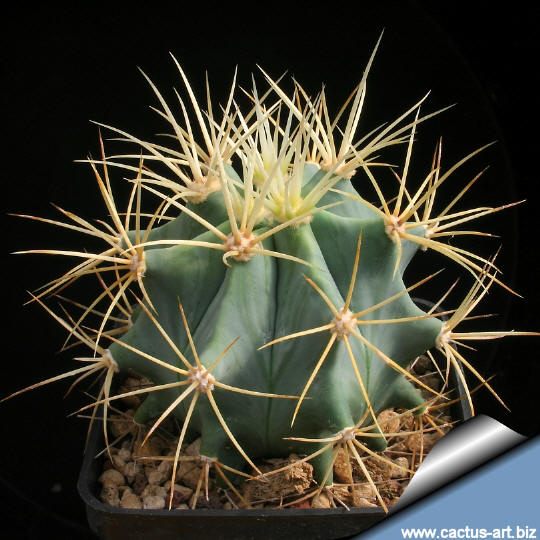Ferocactus glaucescens can be a very neat, compact and attractive addition to any collection. This Blue Barrel Cactus can reach up to 22 inches tall (55 cm), 20 inches across (50 cm)
Translate This Page
Ferocactus glaucescens
Family: Cactaceae (Cactus Family)
Scientific name: Ferocactus glaucescens (DC.) Britton & Rose
Etymology:
Origin: Eastern central Mexico,
Conservation status: Listed in CITES appendix 2.
Habitat: native to the limestone hills of
Common English Names: glaucous barrel cactus; Blue Barrel Cactus
Synonyms: Bisnaga glaucescens; Echinocactus glaucescens; Echinocactus pfeifferi; Ferocactus pfeifferi
]Picture was taken from cactus-art.biz |
|
Ferocactus glaucescens from my collection
The glaucous (blue grey-green) appearance of this barrel with the nice light golden spines makes it very easy to identify.
This Ferocactus stands out from the other species. The spines are rather neatly distributed, and the unusual-looking white fruits are unmistakable. Though it can reach over
Description: It is a spherical or cyclindrical cactus growing to
Stem:. Glaucous grey, up to
Roots:
Ribs: 11 to 15
Areoles:
Spines:
Radial spines: 6 or 7, 2.5-
Central spine(s): 0 or 1, very similar to the radials.
Roots:
Flowers: Lemon yellow, funnel-shaped, 3-
Bloom time:. Late spring and summer. The flowers last a very long time. The plants start flowering when about
Fruit: White,
Seeds:
Sun Exposure: Sun to Partial Shade
Recommended Temperature Zone: USDA Zone 9b: to
Frost Tolerance: Will take some frost
Heat Tolerance:
Minimum Avg. Temperature:
Soil pH requirements:
6.1 to 6.5 (mildly acidic)
6.6 to 7.5 (neutral)
7.6 to 7.8 (mildly alkaline)
Watering Needs:
Cultivation: Plants are slow growing to start, but are easy to grow and require little care once they have reached a nice flowering size. F. glaucescens is suited for any rich, well drained soil in full sun, through-out the year. Pot culture: It grows best in a fairly roomy, well-drained container filled with a porous cactus soil mixture that doesn't contain too much humus. To insure robust plants, water and fertilize during the aestival growth cycle. This plant needs plenty of water (indicatively, about once a week). But it's necessary to avoid wetting the bodies of these plants while they are in sunlight. A wet cactus in the sun light can cause sun burning which can lead to scars, or even fungal infections and death. In winter keep completely dry at
Propagation: Seeds are the typical way of reproducing. These cacti will easily grow from seeds and some from cuttings. Seeds can be sown in the spring or summer in well-drained pots of soil for cacti. Sow the seeds thinly on top. Cover them with a bit of fine quartz grit. Moisten and lay a piece of glass across the top. The pots should be set in a warm greenhouse until they start to sprout, after which the glass should be progressively removed so they can receive full light and air. It isn't good to keep the glass over the seedlings. The well developed seedlings can be planted separately in small pots.
Cuttings made from pieces of the stem of any size can be detached and laid aside for a few days to allow a protective "skin" to form over the cut. They can then be planted in pots. Place them in a spot where they'll receive sun, and do not water until the soil becomes fairly dry. After a while the soil can be moistened regularly, but never kept constantly saturated.
Notes: It has gained the Royal Horticultural Society's Award of Garden Merit.[1]
To qualify for an AGM, a plant: must be available; must be of outstanding excellence for garden decoration or use; must be of good constitution; must not require highly specialist growing conditions or care; must not be particularly susceptible to any pest or disease; must not be subject to an unreasonable degree of reversion.
